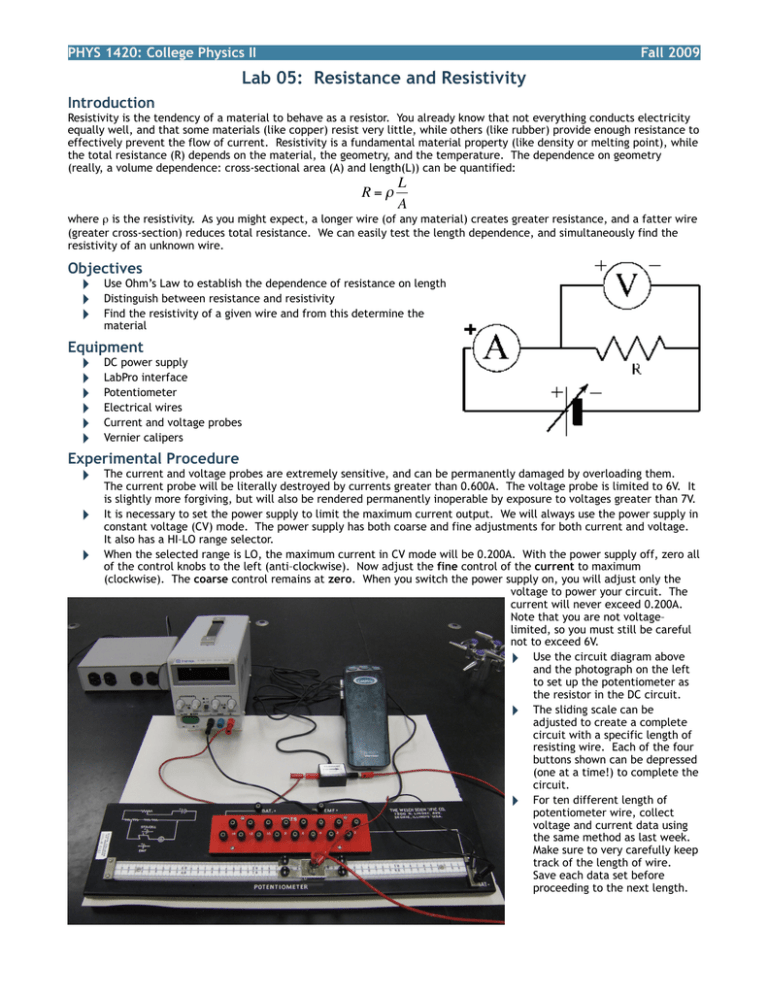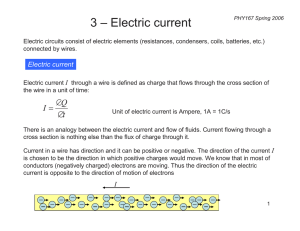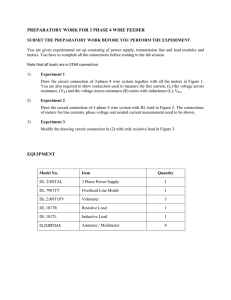Lab 05: Resistance and Resistivity
advertisement

PHYS 1420: College Physics II Fall 2009 Lab 05: Resistance and Resistivity Introduction Resistivity is the tendency of a material to behave as a resistor. You already know that not everything conducts electricity equally well, and that some materials (like copper) resist very little, while others (like rubber) provide enough resistance to effectively prevent the flow of current. Resistivity is a fundamental material property (like density or melting point), while the total resistance (R) depends on the material, the geometry, and the temperature. The dependence on geometry (really, a volume dependence: cross-sectional area (A) and length(L)) can be quantified: R=ρ L A where ρ is the resistivity. As you might expect, a longer wire (of any material) creates greater resistance, and a fatter wire (greater cross-section) reduces total resistance. We can easily test the length dependence, and simultaneously find the resistivity of an unknown wire. Objectives ‣ ‣ ‣ € Use Ohm’s Law to establish the dependence of resistance on length Distinguish between resistance and resistivity Find the resistivity of a given wire and from this determine the material Equipment ‣ ‣ ‣ ‣ ‣ ‣ DC power supply LabPro interface Potentiometer Electrical wires Current and voltage probes Vernier calipers Experimental Procedure ‣ ‣ ‣ The current and voltage probes are extremely sensitive, and can be permanently damaged by overloading them. The current probe will be literally destroyed by currents greater than 0.600A. The voltage probe is limited to 6V. It is slightly more forgiving, but will also be rendered permanently inoperable by exposure to voltages greater than 7V. It is necessary to set the power supply to limit the maximum current output. We will always use the power supply in constant voltage (CV) mode. The power supply has both coarse and fine adjustments for both current and voltage. It also has a HI–LO range selector. When the selected range is LO, the maximum current in CV mode will be 0.200A. With the power supply off, zero all of the control knobs to the left (anti–clockwise). Now adjust the fine control of the current to maximum (clockwise). The coarse control remains at zero. When you switch the power supply on, you will adjust only the voltage to power your circuit. The current will never exceed 0.200A. Note that you are not voltage– limited, so you must still be careful not to exceed 6V. Use the circuit diagram above and the photograph on the left to set up the potentiometer as the resistor in the DC circuit. The sliding scale can be adjusted to create a complete circuit with a specific length of resisting wire. Each of the four buttons shown can be depressed (one at a time!) to complete the circuit. For ten different length of potentiometer wire, collect voltage and current data using the same method as last week. Make sure to very carefully keep track of the length of wire. Save each data set before proceeding to the next length. ‣ ‣ ‣ PHYS 1420: College Physics II Fall 2009 Questions 1. 2. 3. Measure and record the diameter (d) of the wire using the vernier calipers. Use this to calculate the cross-sectional area of the wire. If you have not already, graph the voltage and current data for each length of wire. The slope of each line is the resistance for that specific length of wire. Keep track by making a table of values for length of wire and corresponding resistance. Because the resistivity (ρ) and area (A) of the wire are constant, the resistance is directly proportional to the length: ρ R = L A where (ρ/A) is the proportionality constant, or slope of the R vs. L curve. Graph this data, fit the curve, and extract the slope. 4. Calculate the resistivity of your wire: € ρ ρ slope = = 2 A πr OR ρ = ( slope)( πr 2 ) where slope is the slope of your R vs. L curve and r is the radius of the wire (r = ½d). Compare this value to Table 17.1 (page 577) of your text, and determine the material of the wire. How close did you get to the actual value? Calculate the percent error in your experimental value. € €



